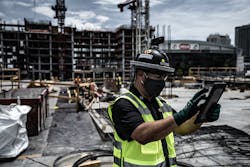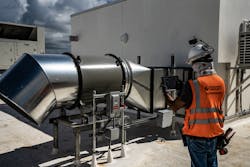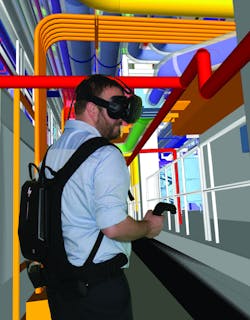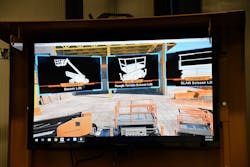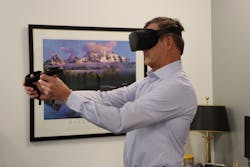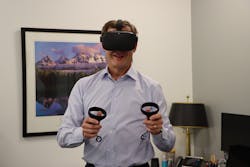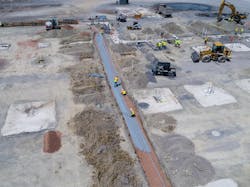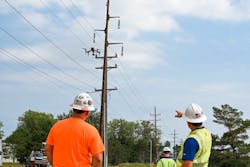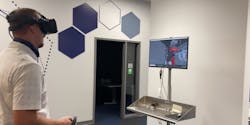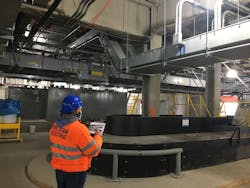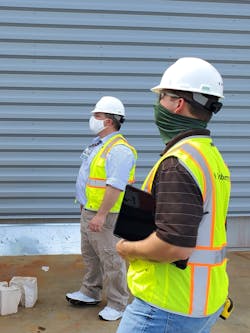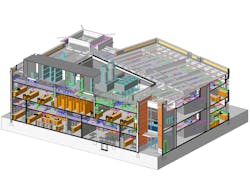In today’s construction climate, electrical contractors and engineers must still wrap up projects on time and within budget — even in the midst of skilled labor shortages, material delays, and the global pandemic. To stay competitive, companies are investing in the latest virtual technologies.
“The farther behind that we fall, the more we hinder our team from growing and meeting the demands of an ever-decreasing project timeline,” Samaniego says. “The market is also very competitive right now, and it is vital to enable our teams to be as efficient as possible to compete.”
Implementing various construction technologies has also saved time for Victor, N.Y.-based O’Connell Electric. For example, through Virtually Designed Construction (VDC), the electrical contractor can improve both layout processes and actual installations. In addition, using 3D scanners and software creates faster, more accurate layouts, leading to time savings.
Power Design
Solving field challenges in real time
Building Information Modeling (BIM) has brought St. Petersburg, Fla.-based Power Design’s Virtual Design and Engineering teams together in a more streamlined, collaborative environment, says Dave Hughes, director of virtual design and construction.
For more than a decade, the MEPS contractor has been using BIM, and the company has been researching and developing its VR and AR programs for about four years. To teach its team how to use the technology, Power Design develops and deploys all of its BIM training in-house. The subject matter experts (SMEs) have developed the content and facilitated the hands-on lab training and virtual classrooms.
Power Design leverages the visual components of BIM design to engage its SMEs in the field. In addition, its employees wear hard-hat cameras that capture job-site footage.
“We are able to identify and solve potential deviations in real time,” Hughes says.
By using the trending deviation data from these technologies, Power Design can improve the constructability components of its engineering design. In turn, the company can drive more efficient installations.
In the future, the contractor is looking for more opportunities to leverage new technology.
“We are looking into expanding our fleet of Robotic Total Stations, Scanning Technology for installation verification and as-builts, and learning about more AR field applications,” Hughes says.
Rosendin Electric
Training employees and improving productivity
BIM is the cornerstone virtual technology for Rosendin Electric, San Jose, Calif. By creating an information-rich 3D model of a project, the contractor can iron out many of the unforeseeable issues before they arise in the field — translating to better productivity, efficiency, and profitability, Samaniego says.
To further capitalize on BIM, the contractor is leveraging several technologies like AR and VR. With AR, the contractor can extend accessibility to BIM and its embedded information to the field. While AR is used primarily for pre-planning, quality analysis, and quality control/layout verification, VR enables office personnel to have a full-scale interaction with the model and can be used for coordination.
Additionally, Rosendin is developing training and assessments based in VR, which allows the company to better assess and certify its field personnel without putting them in harm’s way with active electrical equipment or an active job site.
Rosendin develops its virtual technologies through a dedicated innovation team whose primary focus is to research emerging technologies, both inside and outside construction, to determine how to meet its needs and improve processes.
“The team often works in reverse, analyzing our current processes to determine possible areas of improvement, and either finds or develops the required solutions,” says Dr. Jad Chalhoub, BIM technologies solutions implementation lead. “Many of the technologies and tools that we use are internally developed due to not finding suitable, commercially available solutions.”
A training team works with the end users — including engineers, modelers, and field personnel — to ensure they have the proper access and training to the technology.
“The technology exists to serve the user, and we are committed to refining and adapting it to best serve them in whichever way they need,” Chalhoub says.
Beyond AR, VR, AI, and BIM, Rosendin is constantly monitoring automation, using drone scanners and robotics, to handle repetitive manual tasks in the field. The company also is looking into software solutions to automate parts of the modeling and coordination process.
“Technology and innovation are fast, moving targets with something new happening almost every day,” Samaniego says.
Smith Seckman Reid
Exploring new technologies on a project-by-project basis
With new technologies rapidly changing, Nashville, Tenn.-based Smith Seckman Reid (SSR) is investing in employees who can quickly adapt and become proficient, staying aware of new virtual technologies and developing proficiencies based on client needs, on a project-by-project basis, says Jesse Felter, commissioning discipline manager.
For example, on certain high-level, large-scale projects, companies must commit to using new technologies to coordinate between engineers and contractors, says Cody Swayze, EI, LEED AP and Electrical EIT.
SSR uses BIM 3D modeling and clash detection software to maintain coordination in the design of systems across all trades. The type of project delivery also impacts SSR’s involvement in clash detection via various AR and VR platforms throughout the construction phase of the project to ensure constructability of design, he says.
“Investment in these types of software can be expensive, and therefore typically must have owner buy-in as an extended service,” Swayze says. “We as engineers must be willing to adopt the new software and quickly adapt.”
SSR’s team was one of the early adopters in the design engineering world to use BIM 3D modeling and virtual clash detection software. The company now has dedicated BIM team members to facilitate complex processes and create proprietary software tailored to its designs.
As far as AR and VR platforms go, SSR is relatively new to using these technologies. When the company is asked to adopt these technologies as part of its design and consulting services, its engineers learn how to use the programs. For example, the team has used VR to provide better visualization of a space or areas to test out design options to provide the best aesthetic appeal for the architect and owner, Swayze says.
“Previously, our firm and other firms across the industry used a simple overlay of drawings to detect clashes, and we relied on architectural renderings alone to visualize spaces,” Swayze says. “Now, our productivity has greatly increased, as these programs are able to determine clashes within a given set of parameters that the engineers are able to alter and control. We are also able to see changes across all disciplines live as they happen and can react much more quickly to these changes.”
Looking forward, SSR is looking at furthering its training in VR to more and more of its colleagues.
“We are looking for new ways these technologies can be used to enhance the products and services we are able to deliver to clients,” Swayze says.
O’Connell Electric Company
Keeping pace with technology changes
When O’Connell Electric first started investing in virtual technologies, the New York-based electrical contractor constantly scanned the internet, reached out to other contractors, and partnered with software designers to create products to increase efficiency.
“This is still an ongoing endeavor since technology is constantly evolving,” says Rob Sampson, virtual design team lead.
To stay up to date on the latest technologies, the company created a virtual design team, whose members not only understand the electrical industry, but also have a strong computer background and can leverage rapidly developing technologies.
“As we built this team, we were constantly vetting out new software as the electrical industry was rushing to get up to speed with the mechanical world that had been utilizing these design software programs for years,” says Brian Rittenhouse, vice president of construction and construction services.
Currently, the electrical contractor is exploring both AR and VR options. VR helps individuals who are not used to viewing a 3D environment to better visualize the design of the project and the user to become “part” of the design model and move about it more naturally. AR technologies can include demonstrations/walkthroughs for various assembly or troubleshooting situations, making dangerous situations potentially safer.
“By adopting AR technologies, one could conceivably view a completed project, while they are standing in a freshly excavated pit,” Sampson says. “AR could be used in the field to see conflicts amongst trades, before the actual installation. This could lead to the re-work being done before the actual work has taken place.”
Currently, the contractor uses different virtual technologies, including BIM, 3D scanners and Robotic Total Stations, to ensure everyone on a project team is on the same page, translate the design into real-world dimensions, and perform layout of the designed work.
“Construction technologies have allowed us to bring our coordinated 3D model to the field,” Sampson says.
O’Connell, which was founded in 1911, has been focused on adopting these newer construction software technologies for just over seven years now. O’Connell is always trying to stay ahead of the technology curve to constantly improve its productivity and safety results.
“We know from past experience that if we do not take this approach, that our tremendous success could be put in jeopardy,” says Victor Salerno, CEO. “Most investments in technology have been very successful except for a few minor failures.”
Interstates
Saving time in the field
With the demand for skilled workers growing and the supply declining, electrical contractors must push technology as much as possible to boost workers’ efficiency, says Dave Ver Hoef, a VDC technician at Interstates, Sioux Center, Iowa.
By using both AR and VR in the field, the project team members can share what they have modeled in 3D.
“It grants the field the ability to see what the installation might look like and the routes that might work,” Ver Hoef says. “We are able to use this technology on about any project that allows, especially those which require a large amount of coordination with other contractors.”
A team of employees researches new technology and tests it out. Interstates then conducts in-house training sessions for its field electricians and educates its team on the technology and how it can be incorporated on their sites.
When rolling out the technology to the office and the field, the deployment can take a significant investment. During certain times, the technology may not work, requiring visits to the site or sending the equipment back for troubleshooting, Ver Hoef says.
Despite the challenges with the new technology, it can also offer benefits. For example, at Interstates, electricians are using technology for reviewing electrical routes, electrical equipment placements, and any potential collisions with other trade equipment.
“This allows our teams to be more productive by saving them time and rework by being able to make adjustments in the model before installation,” Ver Hoef says.
Five Star Electric
Streamlining the transfer of data from the office to the field
From tablets, construction apps, software, and field devices to document control and BIM modeling, Five Star Electric, New York, has always tried to adapt and incorporate these technologies into its day-to-day routines.
“Technology can be incorporated into every aspect of our business,” Lancey says. “It increases efficiency, accuracy, speed, and effectiveness in both the office and on our construction sites.”
Specific to virtual technology, Five Star Electric has been using 3D technology for decades, and as it has advanced, so has the company. For its business, the contractor uses 3D technology mainly in BIM modeling and in 3D coordination. What started as a contractual requirement for its World Trade Center projects quickly grew into a standard for many of its projects. Five Star Electric has taken advantage of this technology’s benefits, specifically virtual clash detection with other trades work and other features that help with equipment selection and conduit placement during a project’s coordination phase.
“Essentially, you are building the job virtually before building it in reality,” Lancey says. “BIM allows the field electricians to see all the architectural and structural elements of a project in conjunction with the dimensions and elevations or other trades work. Any coordination changes that are required can be made in real time. Because the project has been properly coordinated virtually and in advance of construction, this will allow the electricians to work more efficiently on the job site.”
Five Star Electric equips its field supervisors with tablets, construction-oriented apps and access to in-house databases to constantly receive drawing and model updates, access to project documents, specifications, RFIs, material ordering capabilities, and the ability to track job progress by the use of photo documentation.
Five Star Electric is always looking for more advanced technology to incorporate into all aspects of its business — from engineering and construction to as-built production, document control, reporting and estimating.
“There is truly no limit to its capabilities,” Lancey says. “However, as technology is continuously advancing, we are always cautious to adapt a new technology until such time it is proven to be effective and beneficial to the company.”
Dewberry
Investing in tablets, software, and technology for the workforce
Fairfax, Va.-based Dewberry is currently in a trial phase, which started in October 2020, to test a construction document software to organize all documents for projects. The mission of the program is for Dewberry’s construction administration personnel to be the authority on construction documents for a project — while they are in the field and not just when they are at their desk.
Before using the software, many Dewberry personnel printed drawings prior to performing field visits. They would then take pictures and organize them when they returned to the office. After writing the field reports on paper, they would then input them into a PDF template. Now, however, Dewberry employees can create and organize field observations and punch list items while in the field when they have good situational awareness and the ability to take photos.
“The goal is for the field report to be more than 80% complete when the employee leaves the job site,” says Robert Deaton, assistant department manager. “Once the employee is back in the office after a field visit, this software allows them to quickly and efficiently review the field report again, send it out to the contractors and owners, and move on to the next task.”
By loading the new software on the tablets, Dewberry can ensure that its employees are pulling up the most current set of drawings in the field. In addition, the employees will have real-time access to all equipment submittals, shop drawings, and RFIs.
In the future, Dewberry plans to use 360° site visit photos to make it easier and more efficient for personnel to document construction progress, identify potential issues, and photo document as-built conditions in mechanical/electrical rooms. Also, the company is looking to export the BIM/VDC model from the construction team to Dewberry field personnel’s tablets so they can be referenced in the field.
“We also expect to purchase additional tablets so more Dewberry field personnel can take advantage of the software,” Deaton says.
HEAPY
Virtually connecting with clients and colleagues
Building design requires both planning and collaboration, says Dwayne Henderson, information communication and technology practice director at HEAPY, an engineering design, and construction administration firm.
“We use communication and collaboration tools, as well as BIM to deliver a better project for our clients,” Henderson says. “Ultimately, these tools make clients feel more connected to the project and help our team meet client expectations, which results in better outcomes for everyone.”
HEAPY uses BIM for every project to anticipate and model day-to-day progress, as well as coordinate deliverables and responsibilities in real-time.
“This technology allows our team to handle and address issues as they arise and before they become problems in the field,” Henderson says. “Using BIM can also help our clients better understand project progress and make sure we are bringing their vision to life. In addition, we can save time and resources because we reduce the need for colleagues and clients to travel to physical locations.”
The COVID-19 pandemic highlighted the need for more integrated service delivery, but HEAPY was an early adopter of remote work and BIM technology, Henderson says.
“These integrated tools allow us to better serve our clients, and our clients are now more comfortable with virtual reviews and progress meetings,” Henderson says. “The pandemic has simply accelerated widespread adoption of tools that HEAPY has been using for many years.”
Because the HEAPY team is never physically located in the same office at the same time, virtual collaboration and project management software can open the door to more perspectives and input at each stage of a project.
“In the past, many of HEAPY’s projects proceeded in a very linear fashion,” Henderson says. “Now, many conversations and meetings can be happening simultaneously throughout each project stage. Owners, architects, and construction managers are more active in each phase and aspect of the design, and response time is much faster when we need to solve problems or make decisions.”
In the future, HEAPY looks to further explore technologies that leverage artificial intelligence and VR to improve client communication and experience.
“Technology changes every hour of every day, and our firm is always thinking about how to leverage new tools to serve our colleagues and our clients,” Henderson says. “Most importantly, we vet new tools and software with a lot of feedback and input from the end-users — our engineers and our clients. If you don’t listen to your end-users, you can end up with poor technology selection and adoption.”
SIDEBAR: Five Tips for Getting Buy-In for Virtual Reality
Rosendin Electric offers these five tips to successfully deploy a new technology at your company.
1. Look past the gimmicks of the technology to realize the actual value. At Rosendin, one of the most significant challenges for adoption was getting the teams to discover the value beyond the magic trick, says Dr. Jad Chalhoub of Rosendin.
2. Fix bugs that arise. Discover ways to improve the process of using the technology.
3. Address specific challenges. Virtual reality can cause the older generation to feel motion sickness, so Rosendin worked to reduce the amount of motion needed for the programs it built for VR.
4. Realize that perfection is the enemy of progress. Not everyone has to use every technology, and not every technology has to be used in every scenario.
5. Build a team and create processes. After the team deploys a new technology, the members can continuously review performance, identify bottlenecks and work on finding or developing a solution.
Amy Fischbach is a freelance writer based in Overland Park, Kan. She can be reached at [email protected].

